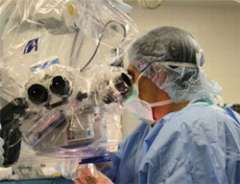Pituitary & Skull Base Tumor
Minimally Invasive Surgery
Find your care
We treat pituitary tumors using the latest innovations in minimally invasive procedures. To connect with an expert in the pituitary tumor program, call 310-825-5111.
Minimally invasive surgery is used by neurosurgeons at UCLA whenever these techniques can achieve comparable or better results compared to standard open surgical procedures. State-of-the-art, minimally invasive neuronavigation technology minimizes incisions and often allows surgeons to cosmetically hide scars.
Minimally Invasive Procedures
Some of the minimally invasive surgery techniques used by neurosurgeons at UCLA are listed below:
Microcraniotomy

Surgical microscope used for minimally invasive surgery.
- UCLA neurosurgeons perform this minimally invasive surgery operation in the intraoperative MRI suite at UCLA.
- For certain brain tumors deep under the surface of the brain, a narrow opening (about half an inch in diameter) can be used to reach the tumor.
- The narrow, minimally invasive surgery opening minimizes damage to normal brain tissue overlying the tumor.
- In other cases, precise stereotactic neuronavigation may allow very small skin incisions and bony openings (craniotomy) for removal of brain tumors.
Neuroendoscopy
- This minimally invasive surgery technique uses specialized endoscopes with high resolution video cameras to perform surgery of the brain.
- Smaller incisions and bony openings often result in less pain and shorter hospital stays.
- UCLA neuroendoscopic surgeons have expertise in a wide variety of minimally invasive endoscopic procedures, including:
- Colloid cyst
- Endonasal, transphenoidal removal of pituitary tumor.
- Endonasal removal of meningioma.
- Craniopharyngioma
- UCLA neuroendoscopic surgeons
- Specially trained neurosurgeons at UCLA perform this minimally invasive surgery procedure.
- A small incision (less than an inch) is needed for a neuroendoscopy.
- Many brain tumor operations that previously required a large scalp incision and large bony opening (craniotomy) can be performed as minimally invasive surgery - using smaller incisions and craniotomy openings.
- One example is the "eyebrow" approach, which allows removal of tumors above, between, or behind the eye using a "key hole" craniotomy.
- Some of the tumors that possibly can be approached using minimally invasive "key hole" craniotomies include:
Specially trained UCLA neurosurgeons perform this minimally invasive surgery procedure.
More about our expert team >